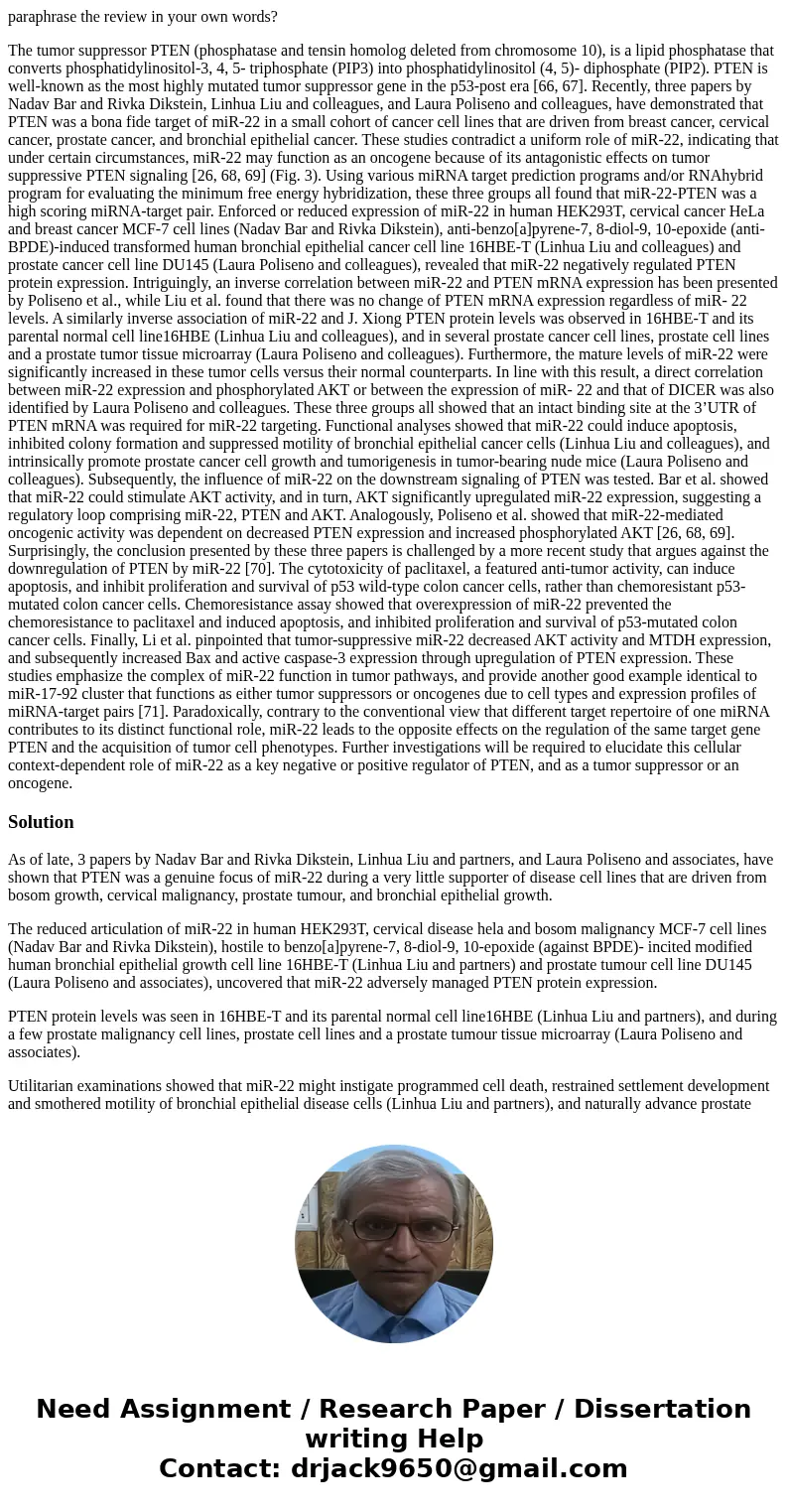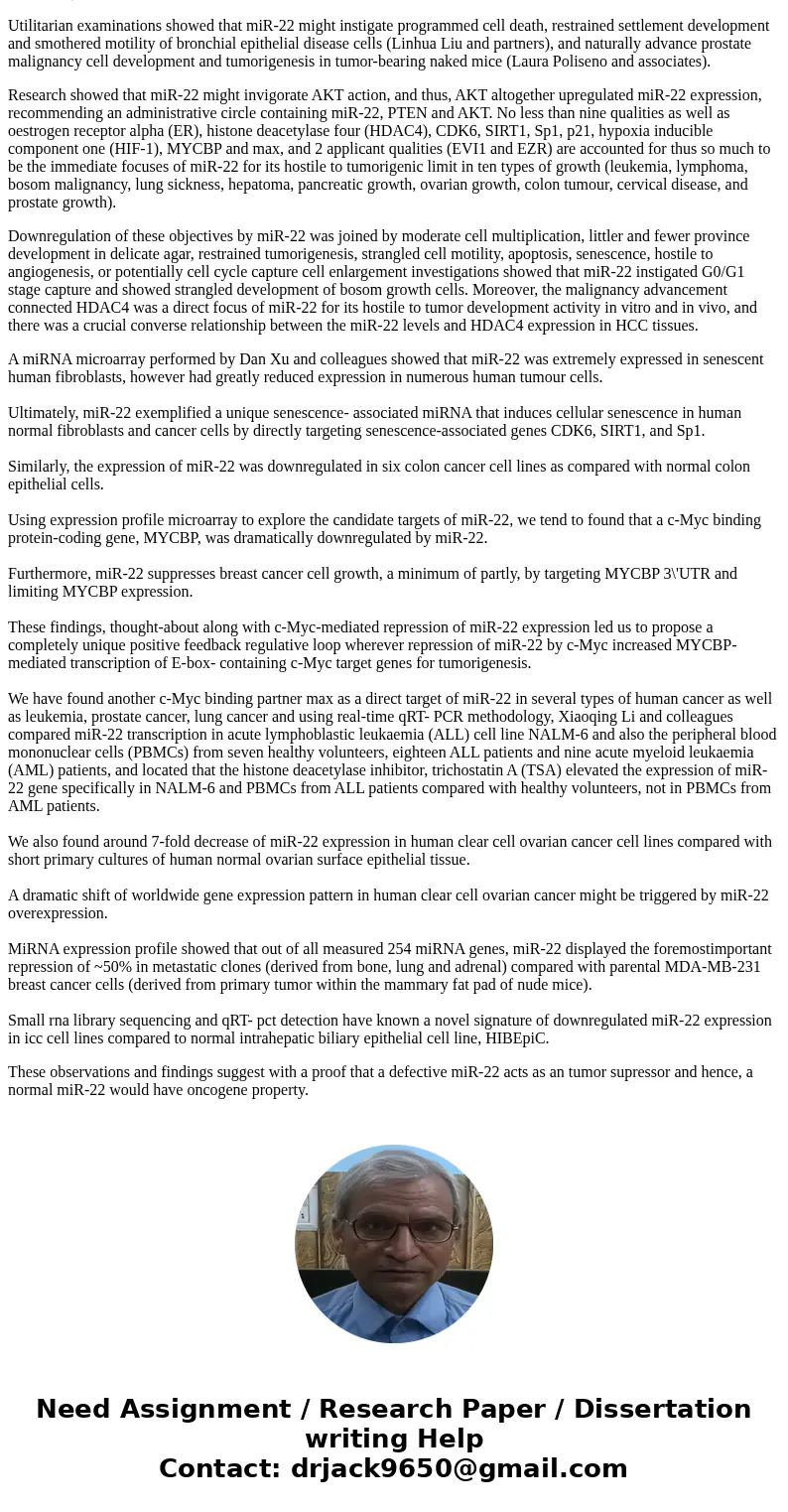paraphrase the review in your own words The tumor suppressor
paraphrase the review in your own words?
The tumor suppressor PTEN (phosphatase and tensin homolog deleted from chromosome 10), is a lipid phosphatase that converts phosphatidylinositol-3, 4, 5- triphosphate (PIP3) into phosphatidylinositol (4, 5)- diphosphate (PIP2). PTEN is well-known as the most highly mutated tumor suppressor gene in the p53-post era [66, 67]. Recently, three papers by Nadav Bar and Rivka Dikstein, Linhua Liu and colleagues, and Laura Poliseno and colleagues, have demonstrated that PTEN was a bona fide target of miR-22 in a small cohort of cancer cell lines that are driven from breast cancer, cervical cancer, prostate cancer, and bronchial epithelial cancer. These studies contradict a uniform role of miR-22, indicating that under certain circumstances, miR-22 may function as an oncogene because of its antagonistic effects on tumor suppressive PTEN signaling [26, 68, 69] (Fig. 3). Using various miRNA target prediction programs and/or RNAhybrid program for evaluating the minimum free energy hybridization, these three groups all found that miR-22-PTEN was a high scoring miRNA-target pair. Enforced or reduced expression of miR-22 in human HEK293T, cervical cancer HeLa and breast cancer MCF-7 cell lines (Nadav Bar and Rivka Dikstein), anti-benzo[a]pyrene-7, 8-diol-9, 10-epoxide (anti-BPDE)-induced transformed human bronchial epithelial cancer cell line 16HBE-T (Linhua Liu and colleagues) and prostate cancer cell line DU145 (Laura Poliseno and colleagues), revealed that miR-22 negatively regulated PTEN protein expression. Intriguingly, an inverse correlation between miR-22 and PTEN mRNA expression has been presented by Poliseno et al., while Liu et al. found that there was no change of PTEN mRNA expression regardless of miR- 22 levels. A similarly inverse association of miR-22 and J. Xiong PTEN protein levels was observed in 16HBE-T and its parental normal cell line16HBE (Linhua Liu and colleagues), and in several prostate cancer cell lines, prostate cell lines and a prostate tumor tissue microarray (Laura Poliseno and colleagues). Furthermore, the mature levels of miR-22 were significantly increased in these tumor cells versus their normal counterparts. In line with this result, a direct correlation between miR-22 expression and phosphorylated AKT or between the expression of miR- 22 and that of DICER was also identified by Laura Poliseno and colleagues. These three groups all showed that an intact binding site at the 3’UTR of PTEN mRNA was required for miR-22 targeting. Functional analyses showed that miR-22 could induce apoptosis, inhibited colony formation and suppressed motility of bronchial epithelial cancer cells (Linhua Liu and colleagues), and intrinsically promote prostate cancer cell growth and tumorigenesis in tumor-bearing nude mice (Laura Poliseno and colleagues). Subsequently, the influence of miR-22 on the downstream signaling of PTEN was tested. Bar et al. showed that miR-22 could stimulate AKT activity, and in turn, AKT significantly upregulated miR-22 expression, suggesting a regulatory loop comprising miR-22, PTEN and AKT. Analogously, Poliseno et al. showed that miR-22-mediated oncogenic activity was dependent on decreased PTEN expression and increased phosphorylated AKT [26, 68, 69]. Surprisingly, the conclusion presented by these three papers is challenged by a more recent study that argues against the downregulation of PTEN by miR-22 [70]. The cytotoxicity of paclitaxel, a featured anti-tumor activity, can induce apoptosis, and inhibit proliferation and survival of p53 wild-type colon cancer cells, rather than chemoresistant p53-mutated colon cancer cells. Chemoresistance assay showed that overexpression of miR-22 prevented the chemoresistance to paclitaxel and induced apoptosis, and inhibited proliferation and survival of p53-mutated colon cancer cells. Finally, Li et al. pinpointed that tumor-suppressive miR-22 decreased AKT activity and MTDH expression, and subsequently increased Bax and active caspase-3 expression through upregulation of PTEN expression. These studies emphasize the complex of miR-22 function in tumor pathways, and provide another good example identical to miR-17-92 cluster that functions as either tumor suppressors or oncogenes due to cell types and expression profiles of miRNA-target pairs [71]. Paradoxically, contrary to the conventional view that different target repertoire of one miRNA contributes to its distinct functional role, miR-22 leads to the opposite effects on the regulation of the same target gene PTEN and the acquisition of tumor cell phenotypes. Further investigations will be required to elucidate this cellular context-dependent role of miR-22 as a key negative or positive regulator of PTEN, and as a tumor suppressor or an oncogene.
Solution
As of late, 3 papers by Nadav Bar and Rivka Dikstein, Linhua Liu and partners, and Laura Poliseno and associates, have shown that PTEN was a genuine focus of miR-22 during a very little supporter of disease cell lines that are driven from bosom growth, cervical malignancy, prostate tumour, and bronchial epithelial growth.
The reduced articulation of miR-22 in human HEK293T, cervical disease hela and bosom malignancy MCF-7 cell lines (Nadav Bar and Rivka Dikstein), hostile to benzo[a]pyrene-7, 8-diol-9, 10-epoxide (against BPDE)- incited modified human bronchial epithelial growth cell line 16HBE-T (Linhua Liu and partners) and prostate tumour cell line DU145 (Laura Poliseno and associates), uncovered that miR-22 adversely managed PTEN protein expression.
PTEN protein levels was seen in 16HBE-T and its parental normal cell line16HBE (Linhua Liu and partners), and during a few prostate malignancy cell lines, prostate cell lines and a prostate tumour tissue microarray (Laura Poliseno and associates).
Utilitarian examinations showed that miR-22 might instigate programmed cell death, restrained settlement development and smothered motility of bronchial epithelial disease cells (Linhua Liu and partners), and naturally advance prostate malignancy cell development and tumorigenesis in tumor-bearing naked mice (Laura Poliseno and associates).
Research showed that miR-22 might invigorate AKT action, and thus, AKT altogether upregulated miR-22 expression, recommending an administrative circle containing miR-22, PTEN and AKT. No less than nine qualities as well as oestrogen receptor alpha (ER), histone deacetylase four (HDAC4), CDK6, SIRT1, Sp1, p21, hypoxia inducible component one (HIF-1), MYCBP and max, and 2 applicant qualities (EVI1 and EZR) are accounted for thus so much to be the immediate focuses of miR-22 for its hostile to tumorigenic limit in ten types of growth (leukemia, lymphoma, bosom malignancy, lung sickness, hepatoma, pancreatic growth, ovarian growth, colon tumour, cervical disease, and prostate growth).
Downregulation of these objectives by miR-22 was joined by moderate cell multiplication, littler and fewer province development in delicate agar, restrained tumorigenesis, strangled cell motility, apoptosis, senescence, hostile to angiogenesis, or potentially cell cycle capture cell enlargement investigations showed that miR-22 instigated G0/G1 stage capture and showed strangled development of bosom growth cells. Moreover, the malignancy advancement connected HDAC4 was a direct focus of miR-22 for its hostile to tumor development activity in vitro and in vivo, and there was a crucial converse relationship between the miR-22 levels and HDAC4 expression in HCC tissues.
A miRNA microarray performed by Dan Xu and colleagues showed that miR-22 was extremely expressed in senescent human fibroblasts, however had greatly reduced expression in numerous human tumour cells.
Ultimately, miR-22 exemplified a unique senescence- associated miRNA that induces cellular senescence in human normal fibroblasts and cancer cells by directly targeting senescence-associated genes CDK6, SIRT1, and Sp1.
Similarly, the expression of miR-22 was downregulated in six colon cancer cell lines as compared with normal colon epithelial cells.
Using expression profile microarray to explore the candidate targets of miR-22, we tend to found that a c-Myc binding protein-coding gene, MYCBP, was dramatically downregulated by miR-22.
Furthermore, miR-22 suppresses breast cancer cell growth, a minimum of partly, by targeting MYCBP 3\'UTR and limiting MYCBP expression.
These findings, thought-about along with c-Myc-mediated repression of miR-22 expression led us to propose a completely unique positive feedback regulative loop wherever repression of miR-22 by c-Myc increased MYCBP-mediated transcription of E-box- containing c-Myc target genes for tumorigenesis.
We have found another c-Myc binding partner max as a direct target of miR-22 in several types of human cancer as well as leukemia, prostate cancer, lung cancer and using real-time qRT- PCR methodology, Xiaoqing Li and colleagues compared miR-22 transcription in acute lymphoblastic leukaemia (ALL) cell line NALM-6 and also the peripheral blood mononuclear cells (PBMCs) from seven healthy volunteers, eighteen ALL patients and nine acute myeloid leukaemia (AML) patients, and located that the histone deacetylase inhibitor, trichostatin A (TSA) elevated the expression of miR-22 gene specifically in NALM-6 and PBMCs from ALL patients compared with healthy volunteers, not in PBMCs from AML patients.
We also found around 7-fold decrease of miR-22 expression in human clear cell ovarian cancer cell lines compared with short primary cultures of human normal ovarian surface epithelial tissue.
A dramatic shift of worldwide gene expression pattern in human clear cell ovarian cancer might be triggered by miR-22 overexpression.
MiRNA expression profile showed that out of all measured 254 miRNA genes, miR-22 displayed the foremostimportant repression of ~50% in metastatic clones (derived from bone, lung and adrenal) compared with parental MDA-MB-231 breast cancer cells (derived from primary tumor within the mammary fat pad of nude mice).
Small rna library sequencing and qRT- pct detection have known a novel signature of downregulated miR-22 expression in icc cell lines compared to normal intrahepatic biliary epithelial cell line, HIBEpiC.
These observations and findings suggest with a proof that a defective miR-22 acts as an tumor supressor and hence, a normal miR-22 would have oncogene property.


 Homework Sourse
Homework Sourse